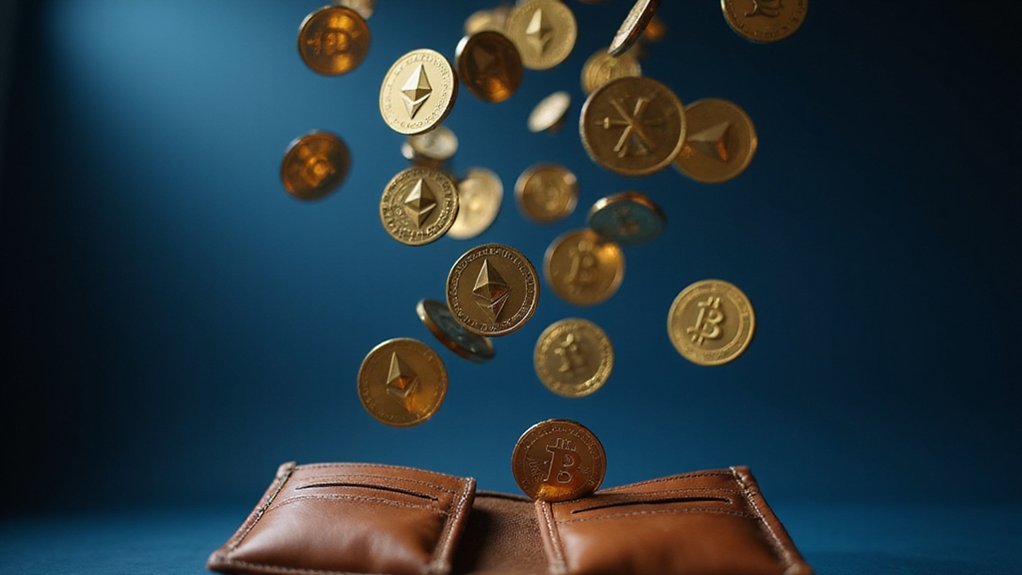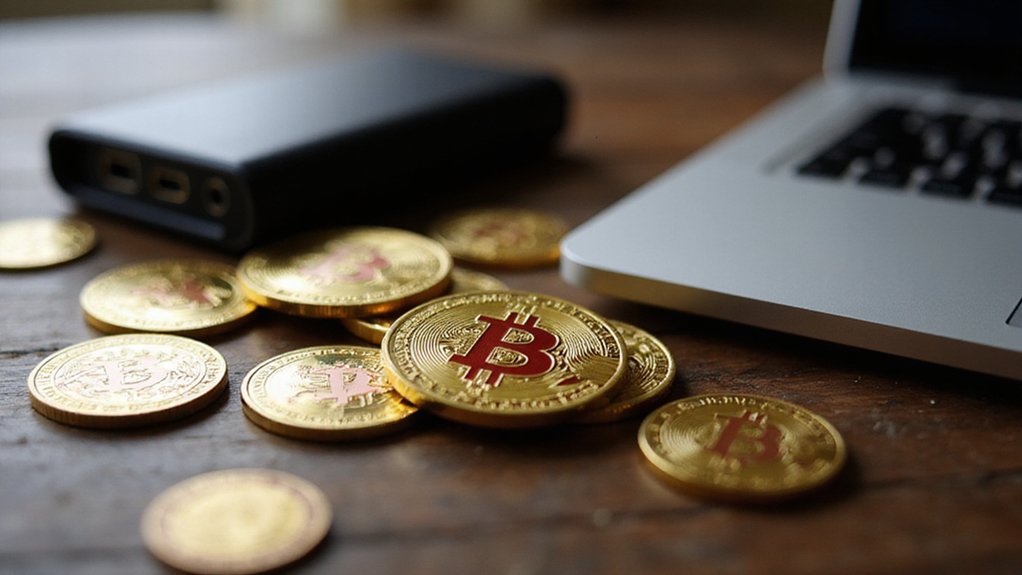A cryptocurrency airdrop distributes free tokens to wallet holders as a marketing mechanism, fundamentally functioning as digital promotional samples with speculative potential. Projects utilize these distributions to generate buzz, build communities, and test market demand without traditional advertising costs. Recipients provide wallet addresses during registration, with eligibility determined through snapshot captures or specific criteria like existing token holdings. While airdrops offer portfolio enhancement opportunities, they carry risks including pump-and-dump schemes and price manipulation—complexities that warrant deeper examination.

While traditional marketing campaigns require substantial budgets and uncertain outcomes, the cryptocurrency world has embraced a peculiar phenomenon known as airdrops—a distribution mechanism where blockchain projects fundamentally throw free tokens at users’ digital wallets in hopes of generating buzz and building communities. This marketing strategy represents perhaps the most democratized form of wealth distribution since the invention of free samples at grocery stores, albeit with considerably more speculative potential.
The mechanics behind airdrops vary considerably, ranging from standard distributions targeting holders of specific cryptocurrencies to more elaborate bounty programs requiring users to complete promotional tasks. Holder airdrops typically mandate maintaining minimum cryptocurrency balances—effectively rewarding existing investors for their commitment (or stubbornness).
Community-focused airdrops reward engagement through forum participation or social media activity, while event-based distributions commemorate project milestones with token showers. Eligibility criteria often resemble an intricate dance of requirements: wallet verification, geographic compliance, task completion, and community engagement metrics. Some projects exclude entire nations due to regulatory complexities, creating a bizarre patchwork of global token accessibility that would make international tax law appear straightforward.
Airdrop eligibility has become a regulatory maze that makes filing taxes in multiple countries seem refreshingly simple by comparison.
The distribution process follows a predictable arc: announcement through various channels, user registration with wallet addresses, verification procedures to eliminate fraudulent participants, and finally token distribution via smart contracts. Projects often employ snapshot capture to identify qualifying holders at specific moments in time, freezing eligibility before final distribution occurs. The irony that projects seeking to decentralize finance still require centralized verification processes rarely escapes notice among cryptocurrency veterans. These smart contracts automatically execute the token distributions when predetermined conditions are met, eliminating the need for manual intervention from project teams.
Benefits extend beyond mere token acquisition. Projects gain visibility, test market demand, and cultivate communities without traditional advertising expenditures. Recipients potentially accumulate portfolio value while projects achieve cost-effective marketing penetration. Whether these distributions constitute genuine value creation or elaborate attention-seeking mechanisms remains hotly debated.
The airdrop phenomenon ultimately reflects cryptocurrency’s experimental nature—an ecosystem where throwing money at strangers represents legitimate business strategy. While recipients celebrate their windfall tokens, projects gamble that free distribution will translate into sustainable adoption. Recipients should exercise caution as pump-and-dump schemes can manipulate token prices after generating initial hype through airdrops.
This symbiotic relationship between token hunters and marketing-minded developers continues evolving, creating an economy where getting something for nothing has become both art form and business model, defying conventional marketing wisdom with characteristic cryptocurrency audacity.
Frequently Asked Questions
Are Cryptocurrency Airdrops Taxable Events That Need to Be Reported?
Cryptocurrency airdrops constitute taxable events in most jurisdictions, requiring recipients to report the fair market value of received tokens as ordinary income.
The IRS and comparable tax authorities treat these “free” distributions as taxable upon receipt—regardless of whether holders immediately sell or retain the assets.
Recipients must calculate the token’s value at distribution time, creating the peculiar scenario of owing taxes on potentially illiquid or worthless digital assets.
How Can I Avoid Airdrop Scams and Protect My Wallet?
Investors should verify airdrop authenticity through official project channels and reputable news sources, avoiding requests for private keys or seed phrases—legitimate distributions never require such information.
Using dedicated wallets for airdrops isolates risks from primary holdings, while rejecting unsolicited offers promising extraordinary returns protects against obvious fraudulent schemes.
Cross-referencing announcements across multiple verified sources and scrutinizing smart contract permissions before connecting wallets provides essential protection against increasingly sophisticated scam operations.
Do I Need to Pay Gas Fees to Claim Airdropped Tokens?
Gas fees depend entirely on the airdrop’s technical architecture.
Automatic deposits require no user fees, while manual claiming through smart contract interactions necessitates paying network transaction costs. Some projects magnanimously sponsor these fees, though users often discover—after researching token legitimacy, as previously discussed—that gas expenses exceed the airdrop’s actual value.
Recipients must maintain sufficient native cryptocurrency (ETH, BNB) in their wallets, since the worthless tokens themselves cannot fund their own claiming transactions.
Can Airdrops Affect the Price of the Original Cryptocurrency Negatively?
Airdrops can indeed depress the original cryptocurrency’s price through multiple mechanisms.
Token dilution increases circulating supply while recipients often liquidate immediately, creating selling pressure.
Market perception suffers when airdrops appear gimmicky, undermining credibility.
Holder behavior shifts unpredictably—some dump original tokens to capture airdrop value, while speculators create artificial price spikes followed by inevitable corrections.
Enhanced liquidity paradoxically increases volatility, and trading volume may migrate to newly listed airdropped tokens.
What Happens to Unclaimed Airdrop Tokens After the Distribution Period?
Unclaimed airdrop tokens typically face a phased expiration process—projects establish initial claim periods (weeks to months), followed by secondary phases requiring direct smart contract interaction.
After extended timeframes (potentially years), unclaimed tokens generally revert to project treasuries or governance funds. Some projects burn these tokens, reducing circulating supply, while others repurpose them for future incentives.
This prevents indefinite token fragmentation, though it inevitably reduces decentralization metrics.









